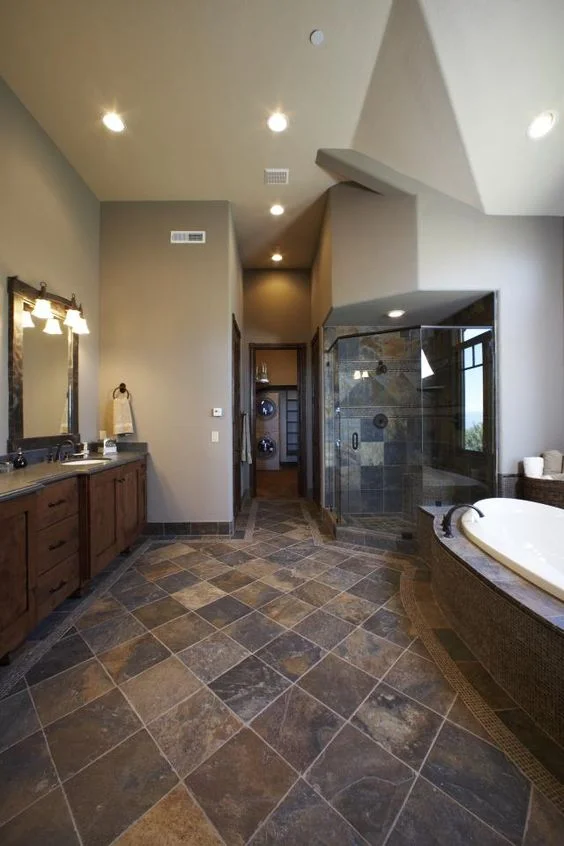Waterproof Flooring Options
Choosing the right bathroom flooring involves prioritizing waterproof options to prevent water damage and ensure longevity. Waterproof flooring is essential in bathrooms due to the constant exposure to moisture and humidity.
- Porcelain and Ceramic Tiles: Porcelain and ceramic tiles are among the most popular waterproof flooring choices for bathrooms. They are impervious to water, easy to clean, and come in a wide range of colors and designs. Porcelain tiles, in particular, are denser and less porous than ceramic tiles, making them highly resistant to water infiltration and staining.
- Luxury Vinyl Tile (LVT): LVT is an excellent waterproof flooring option that mimics the look of natural materials such as wood and stone. It is made of multiple layers, including a waterproof core, making it highly durable and moisture-resistant. LVT is also softer underfoot compared to tiles, providing added comfort.
- Natural Stone: Natural stone flooring options like slate, granite, and marble are naturally water-resistant and can add a touch of luxury to any bathroom. However, they require proper sealing to maintain their waterproof properties and prevent water damage. Regular maintenance is necessary to keep natural stone floors in optimal condition.
- Concrete: Concrete is inherently waterproof and can be customized with various finishes and textures to create a unique look. It is highly durable and easy to clean, making it an ideal choice for bathrooms. Concrete flooring can also be polished, stained, or sealed to enhance its appearance and performance.
- Waterproof Laminate: While traditional laminate is not suitable for bathrooms due to its susceptibility to water damage, waterproof laminate flooring is designed to withstand moisture. It has a water-resistant core and a protective top layer that prevents water from seeping through, making it a practical and stylish choice for bathrooms.
- Rubber Flooring: Rubber flooring is a waterproof and slip-resistant option that is perfect for bathrooms, especially those used by children or elderly individuals. It provides a comfortable underfoot feel, is easy to clean, and comes in various colors and patterns. Rubber flooring also offers excellent shock absorption, reducing the risk of injuries from slips and falls.

Slip-Resistant Materials for Safety
Safety is a paramount concern in bathroom flooring, and choosing slip-resistant materials can significantly reduce the risk of accidents. Various flooring options offer slip-resistant properties, ensuring a safe environment for all bathroom users.
Textured Tiles: Textured porcelain and ceramic tiles are designed to provide better grip, reducing the risk of slips and falls. These tiles come in various textures, such as matte finishes or embossed patterns, enhancing safety without compromising on style. Textured tiles are especially beneficial in wet areas like showers and around bathtubs.
Rubber Flooring: Rubber flooring is inherently slip-resistant, making it an excellent choice for bathrooms. Its non-slip surface provides a secure footing even when wet. Rubber flooring is also comfortable underfoot and available in various colors and designs, allowing for a safe yet stylish bathroom floor.
Natural Stone with a Honed Finish: Natural stone tiles with a honed finish offer slip resistance while maintaining the stone’s natural beauty. The honed finish provides a slightly rough surface, increasing traction and reducing the likelihood of slipping. This finish is particularly suitable for slate, limestone, and travertine tiles used in bathrooms.
Cork Flooring: Cork is a naturally slip-resistant material that provides a cushioned and comfortable surface. It is water-resistant when properly sealed, making it suitable for bathroom use. Cork flooring’s unique texture and anti-slip properties make it a safe and eco-friendly option for bathrooms.
Non-Slip Vinyl Flooring: Non-slip vinyl flooring is designed with a textured surface that enhances grip, reducing the risk of slips and falls. This type of flooring is also waterproof, durable, and easy to maintain. Non-slip vinyl comes in various designs, including wood and stone looks, offering both safety and style.
Anti-Slip Coatings: Applying anti-slip coatings to existing bathroom floors can enhance their safety. These coatings can be applied to various flooring materials, including tiles, concrete, and natural stone, providing an extra layer of slip resistance. Anti-slip coatings are a practical solution for improving safety without replacing the entire floor.
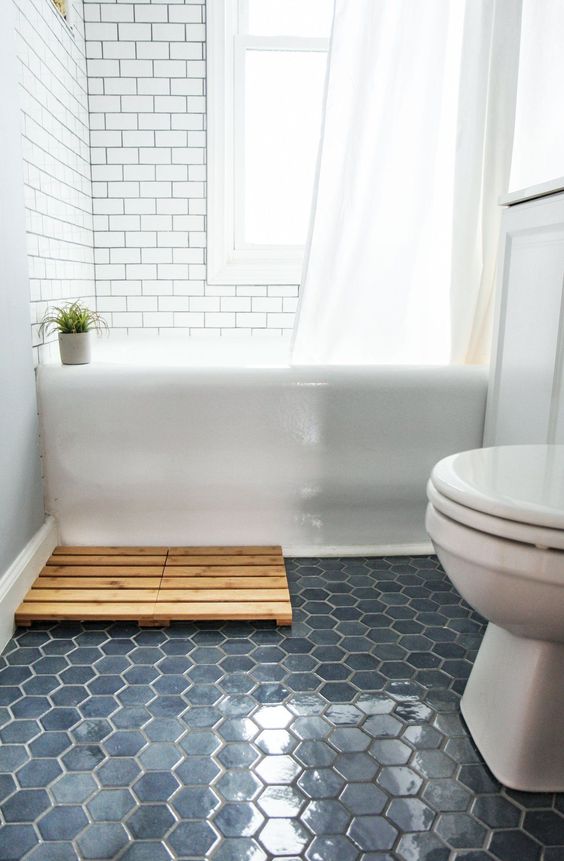
Porcelain and Ceramic Tile Designs
Porcelain and ceramic tiles are versatile and durable options for bathroom flooring, offering a wide range of design possibilities to suit any aesthetic preference.
Classic Subway Tiles: Subway tiles are a timeless choice for bathrooms, known for their clean and classic look. These rectangular tiles can be arranged in various patterns, such as traditional horizontal, vertical, or herringbone, creating a sophisticated and elegant appearance. Subway tiles are available in different colors and finishes, allowing for customization.
Patterned Tiles: Patterned porcelain and ceramic tiles add visual interest and personality to bathroom floors. Moroccan-inspired designs, geometric patterns, and intricate motifs can transform a plain bathroom into a stylish and vibrant space. Patterned tiles can be used for the entire floor or as an accent to create a focal point.
Large Format Tiles: Large format tiles are a contemporary trend that can make small bathrooms appear larger. These tiles, often measuring 12×24 inches or larger, reduce the number of grout lines, creating a seamless and open look. Large format tiles are available in various finishes and colors, offering a modern and sleek aesthetic.
Wood-Look Tiles: Porcelain and ceramic tiles that mimic the appearance of natural wood are a popular choice for bathrooms. These tiles provide the warmth and beauty of wood without the susceptibility to water damage. Wood-look tiles come in various shades and grain patterns, allowing for a realistic and stylish flooring option.
Marble-Look Tiles: Marble-look porcelain and ceramic tiles offer the luxurious appearance of marble without the high maintenance and cost. These tiles replicate the veining and texture of natural marble, creating an elegant and sophisticated look. Marble-look tiles are available in various colors, from classic white to dramatic black.
Hexagon Tiles: Hexagon tiles are a trendy and versatile option for bathroom floors. These six-sided tiles can be arranged in various patterns, such as honeycomb or scattered designs, adding a unique and contemporary touch. Hexagon tiles are available in different sizes, colors, and finishes, providing endless design possibilities.
/amy.bartlam-00839dd16fd4434d99e4c04c89996513.png)
Natural Stone Flooring Choices
Natural stone flooring adds a touch of luxury and elegance to bathrooms, with each type of stone offering unique characteristics and aesthetics.
Marble: Marble is a classic and luxurious choice for bathroom floors. Known for its distinctive veining and wide range of colors, marble adds sophistication and timeless beauty to any bathroom. However, marble is porous and requires regular sealing to prevent water absorption and staining. With proper care, marble can create a stunning and durable bathroom floor.
Slate: Slate is a durable and slip-resistant natural stone option, making it ideal for bathroom floors. It comes in various shades of gray, black, green, and red, adding a rustic and earthy charm to the space. Slate’s natural texture provides excellent grip, enhancing safety in wet areas. Regular sealing is necessary to maintain slate’s water resistance and appearance.
Travertine: Travertine is a versatile and elegant natural stone that comes in warm tones of beige, brown, and gold. Its unique texture and porous nature add character to bathroom floors. Travertine requires sealing to protect against water damage and staining. Its timeless appeal and natural beauty make it a popular choice for classic and traditional bathroom designs.
Granite: Granite is one of the hardest and most durable natural stones, making it an excellent choice for bathroom floors. It is highly resistant to water, stains, and scratches, ensuring a long-lasting and low-maintenance floor. Granite comes in a variety of colors and patterns, from subtle to bold, allowing for versatile design options.
Limestone: Limestone offers a soft and natural look with its earthy tones and subtle textures. It is a durable and long-lasting flooring option when properly sealed and maintained. Limestone’s neutral colors and organic feel make it suitable for both contemporary and traditional bathroom designs. Regular sealing is required to protect against water absorption and staining.
Onyx: Onyx is a unique and luxurious natural stone that adds a dramatic and exotic touch to bathroom floors. Its translucent properties and vibrant colors create a striking and elegant appearance. Onyx is more delicate than other natural stones and requires careful maintenance and sealing to prevent water damage and etching. Despite its high maintenance, onyx’s beauty and uniqueness make it a sought-after choice for high-end bathrooms.

Luxury Vinyl Tile (LVT) Options
Luxury Vinyl Tile (LVT) is a versatile and practical flooring option for bathrooms, offering the look of natural materials with the benefits of durability and water resistance.
Wood-Look LVT: Wood-look LVT provides the warmth and beauty of hardwood flooring without the susceptibility to water damage. It is available in various wood grain patterns and colors, from light oak to dark walnut. Wood-look LVT is ideal for creating a cozy and inviting bathroom space while ensuring durability and ease of maintenance.
Stone-Look LVT: Stone-look LVT mimics the appearance of natural stone, such as marble, slate, and travertine. It offers the same elegance and sophistication as stone flooring but with added durability and water resistance. Stone-look LVT is available in various textures and finishes, allowing for a realistic and stylish bathroom floor.
Textured LVT: Textured LVT features embossed surfaces that enhance the look and feel of natural materials like wood and stone. The textured surface provides better grip and slip resistance, making it a safe choice for bathroom floors. Textured LVT combines aesthetic appeal with practicality, offering a secure and stylish flooring solution.
Patterned LVT: Patterned LVT adds visual interest and personality to bathroom floors. It comes in various designs, including geometric patterns, intricate motifs, and bold prints. Patterned LVT allows for creative and unique flooring designs, transforming a plain bathroom into a stylish and vibrant space.
Rigid Core LVT: Rigid core LVT is designed with a dense core layer that provides enhanced stability and resistance to dents and impacts. This makes it an ideal choice for high-traffic bathroom areas. Rigid core LVT is also waterproof and easy to install, offering a durable and reliable flooring option for bathrooms.
Loose Lay LVT: Loose lay LVT is designed for easy installation and removal. It features a heavy backing that holds the tiles in place without the need for adhesives. Loose lay LVT is a practical choice for bathroom floors, as it allows for quick and hassle-free installation and replacement. It is also waterproof and available in various designs, providing both convenience and style.
Wood-Look Flooring for Bathrooms
Wood-look flooring brings the natural beauty and warmth of wood into bathrooms, combining aesthetics with the practical benefits of water-resistant materials.
Wood-Look Porcelain Tiles: Porcelain tiles that mimic the appearance of wood are an excellent choice for bathroom floors. They offer the beauty of hardwood with the durability and water resistance of porcelain. Wood-look porcelain tiles come in various wood grain patterns and colors, allowing for a realistic and stylish bathroom floor.
Luxury Vinyl Planks (LVP): LVP is a popular wood-look flooring option for bathrooms. It is made of multiple layers, including a waterproof core, making it highly resistant to moisture and humidity. LVP is available in a wide range of wood styles, from traditional oak to exotic teak, offering versatility and easy maintenance.
Engineered Wood: Engineered wood flooring consists of a real wood veneer over a plywood or high-density fiberboard core. It is more stable and moisture-resistant than solid hardwood, making it suitable for bathrooms. Engineered wood provides the authentic look and feel of wood while being more resistant to water damage and warping.
Laminate Flooring: Laminate flooring with a water-resistant core is another wood-look option for bathrooms. It features a photographic layer that replicates the appearance of wood, topped with a protective wear layer. Water-resistant laminate is easy to install and maintain, offering a cost-effective and stylish solution for bathroom floors.
Bamboo Flooring: Bamboo is a sustainable and eco-friendly wood-look flooring option that is becoming increasingly popular in bathrooms. It is naturally water-resistant and highly durable. Strand-woven bamboo is particularly suitable for bathroom use due to its increased density and moisture resistance. Bamboo flooring adds a unique and natural touch to bathroom interiors.
Cork Flooring: Cork is a wood-look flooring option that provides a comfortable and cushioned surface. It is naturally water-resistant when properly sealed, making it suitable for bathroom use. Cork’s unique texture and warmth add a cozy and eco-friendly element to bathroom floors. It also offers excellent sound insulation and is soft underfoot, enhancing comfort and safety.

Budget-Friendly Bathroom Flooring Options
Creating a stylish and functional bathroom doesn’t have to break the bank. Several budget-friendly flooring options can offer durability and aesthetics without high costs.
Vinyl Flooring: Vinyl flooring is one of the most cost-effective options for bathrooms. Available in sheets, tiles, and planks, vinyl is water-resistant and comes in a wide range of designs that mimic more expensive materials like wood and stone. It is also easy to install, making it a popular choice for DIY projects.
Laminate Flooring: Water-resistant laminate flooring is an affordable alternative to hardwood. It features a photographic layer that replicates the look of wood, stone, or tile, topped with a protective wear layer. While traditional laminate is not suitable for bathrooms, water-resistant varieties can withstand moisture and are easy to maintain.
Ceramic Tiles: Ceramic tiles are another budget-friendly option for bathroom floors. They are durable, water-resistant, and available in countless styles, colors, and sizes. Ceramic tiles can be installed in various patterns to create a custom look. Basic ceramic tiles are often more affordable than porcelain or natural stone options.
Peel-and-Stick Tiles: Peel-and-stick vinyl tiles offer a quick and inexpensive solution for updating bathroom floors. These self-adhesive tiles are easy to install and replace, making them ideal for budget-conscious renovations. They come in various designs, including wood and stone looks, providing versatility at a low cost.
Sheet Linoleum: Linoleum is a natural and budget-friendly flooring material made from renewable resources like linseed oil, cork dust, and wood flour. Sheet linoleum is water-resistant and available in a variety of colors and patterns. It is an eco-friendly and affordable option for bathroom flooring.
Painted Concrete: If you have a concrete subfloor, painting it can be a cost-effective way to create a unique and durable bathroom floor. Special concrete paints and sealers can transform the look of the floor, offering endless design possibilities. Painted concrete is easy to clean and maintain, making it a practical choice for budget-conscious homeowners.

Flooring Options for Small Bathrooms
Selecting the right flooring for small bathrooms can make a significant impact on the perception of space and functionality. Certain flooring options can enhance the look and feel of a compact bathroom.
Large Format Tiles: Large format tiles can make a small bathroom appear larger by reducing the number of grout lines and creating a more seamless look. These tiles come in various materials, including porcelain, ceramic, and stone. Light-colored large format tiles can further enhance the sense of space and openness.
Diagonal Tile Layout: Installing tiles in a diagonal pattern can create the illusion of a larger space in a small bathroom. Diagonal layouts draw the eye outward and add visual interest, making the floor appear more expansive. This technique works well with square or rectangular tiles in various materials.
Light-Colored Flooring: Light-colored flooring, such as white, beige, or light gray, can make a small bathroom feel more open and airy. Light colors reflect more light, creating a brighter and more spacious atmosphere. This effect can be achieved with materials like ceramic tiles, vinyl, and laminate.
Reflective Surfaces: Flooring materials with reflective surfaces, such as glossy tiles or polished stone, can enhance the sense of space in a small bathroom. These surfaces reflect light and create a mirror-like effect, making the room appear larger and brighter. However, be cautious with slip resistance when choosing glossy finishes.
Continuous Flooring: Using the same flooring material throughout the entire bathroom, including the shower area, can create a seamless and cohesive look. Continuous flooring eliminates visual breaks, making the space feel more unified and less cluttered. Materials like porcelain tiles, LVT, and concrete are suitable for this approach.
Mosaic Tiles: Mosaic tiles, especially in light colors or glass, can add texture and depth to small bathroom floors. These small tiles can be arranged in various patterns, adding visual interest without overwhelming the space. Mosaic tiles are ideal for creating custom designs and accents in compact bathrooms.

Grout Options and Their Impact on Aesthetics
Grout plays a crucial role in the overall look and performance of bathroom flooring. The color, width, and type of grout can significantly influence the aesthetics and maintenance of the floor.
Grout Color Matching: Matching the grout color to the tile color can create a seamless and uniform look. This approach minimizes the appearance of grout lines and allows the tiles to stand out. For example, white grout with white tiles creates a clean and cohesive appearance, ideal for contemporary and minimalist designs.
Contrasting Grout: Using contrasting grout colors can add definition and highlight the tile pattern. Dark grout with light-colored tiles or vice versa creates a striking visual effect and emphasizes the layout. Contrasting grout is often used in classic designs, such as black grout with white subway tiles, for a bold and timeless look.
Neutral Grout Shades: Neutral grout colors, such as gray or beige, offer a balanced and versatile look that complements various tile colors and styles. Neutral grout can blend well with both light and dark tiles, providing a subtle contrast without overpowering the design. It is a popular choice for achieving a harmonious and sophisticated appearance.
Epoxy Grout: Epoxy grout is a durable and stain-resistant option that is ideal for bathroom floors. Unlike traditional cement-based grout, epoxy grout is non-porous and less prone to discoloration and mold growth. It is available in various colors and provides a long-lasting, low-maintenance solution for high-moisture areas.
Wide Grout Lines: Wide grout lines can add a rustic and traditional charm to bathroom floors. They are often used with larger tiles or natural stone to create a more substantial and textured appearance. However, wide grout lines require more maintenance, as they can collect dirt and grime more easily.
Narrow Grout Lines: Narrow grout lines create a sleek and modern look, making the floor appear more seamless and less busy. They work well with small or large tiles and are easier to clean and maintain. Narrow grout lines are often preferred for contemporary and minimalist designs, providing a clean and polished finish.
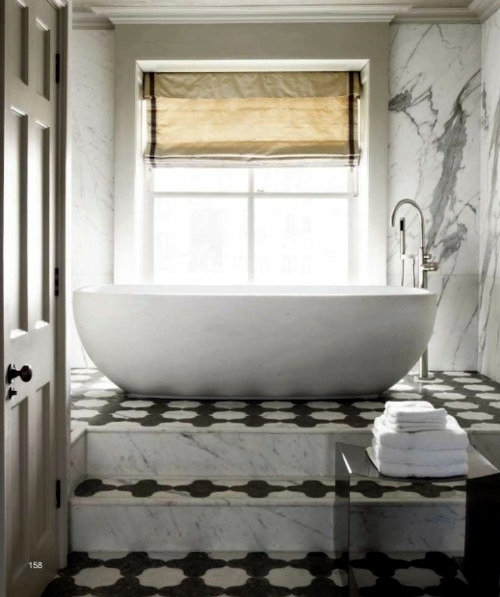
Common Mistakes to Avoid
Avoiding common mistakes when selecting and installing bathroom flooring can ensure a successful and long-lasting outcome.
Ignoring Water Resistance: One of the most crucial mistakes is ignoring the importance of water resistance. Bathrooms are exposed to high moisture levels, and choosing non-waterproof materials can lead to damage, mold, and mildew. Always opt for flooring specifically designed for wet environments, such as porcelain tiles, LVT, or engineered wood.
Overlooking Slip Resistance: Safety should be a top priority in bathroom flooring. Overlooking slip resistance can increase the risk of accidents, especially in wet areas. Select materials with inherent slip-resistant properties or apply anti-slip treatments to ensure a safe bathroom environment. Textured tiles, rubber flooring, and cork are excellent options for enhanced grip.
Poor Subfloor Preparation: Failing to properly prepare the subfloor can compromise the stability and longevity of the new flooring. Issues like uneven surfaces, cracks, or moisture in the subfloor can lead to problems down the line. Ensure the subfloor is clean, dry, and level before installing the new flooring.
Choosing Inappropriate Materials: Not all flooring materials are suitable for bathrooms. Selecting materials that cannot withstand high moisture environments can result in damage and increased maintenance. Avoid using solid hardwood or non-waterproof laminates in bathrooms. Opt for waterproof and moisture-resistant materials instead.
Improper Sealing: For materials like natural stone and concrete, improper sealing can lead to water damage and staining. Ensure these materials are adequately sealed to protect against moisture. Regular resealing is also necessary to maintain their water-resistant properties and appearance.
Skipping Professional Installation: While some bathroom flooring options are DIY-friendly, complex installations or materials like natural stone may require professional expertise. Skipping professional installation can result in mistakes and issues that compromise the floor’s performance and durability. Consider hiring a professional for intricate designs, large format tiles, or challenging installations to ensure a flawless result.

What is the best flooring material for a bathroom?
The best flooring material for a bathroom combines water resistance, durability, and aesthetics. Porcelain and ceramic tiles are popular choices due to their waterproof properties and wide range of designs. Luxury vinyl tile (LVT) is another excellent option, offering the look of natural materials with added durability and ease of maintenance. For a luxurious touch, natural stone like marble or slate can be used, but it requires proper sealing and maintenance. The choice ultimately depends on your budget, style preference, and specific bathroom needs.
How do I ensure my bathroom floor is slip-resistant?
Ensuring a slip-resistant bathroom floor involves choosing the right materials and finishes. Textured porcelain or ceramic tiles, rubber flooring, and cork are naturally slip-resistant options. Additionally, applying anti-slip coatings or treatments to existing floors can enhance their grip. It’s essential to consider areas with high water exposure, like showers and around bathtubs, and use materials designed to provide better traction in these zones. Regular cleaning to prevent the buildup of soap residue and water can also help maintain slip resistance.
Can I use hardwood flooring in my bathroom?
Using traditional solid hardwood flooring in a bathroom is generally not recommended due to its susceptibility to water damage, warping, and staining. However, engineered wood flooring is a better alternative as it consists of a real wood veneer over a stable core that offers improved moisture resistance. For those who prefer the look of wood, wood-look porcelain tiles or luxury vinyl planks (LVP) are excellent alternatives that provide the desired aesthetics with enhanced durability and water resistance.
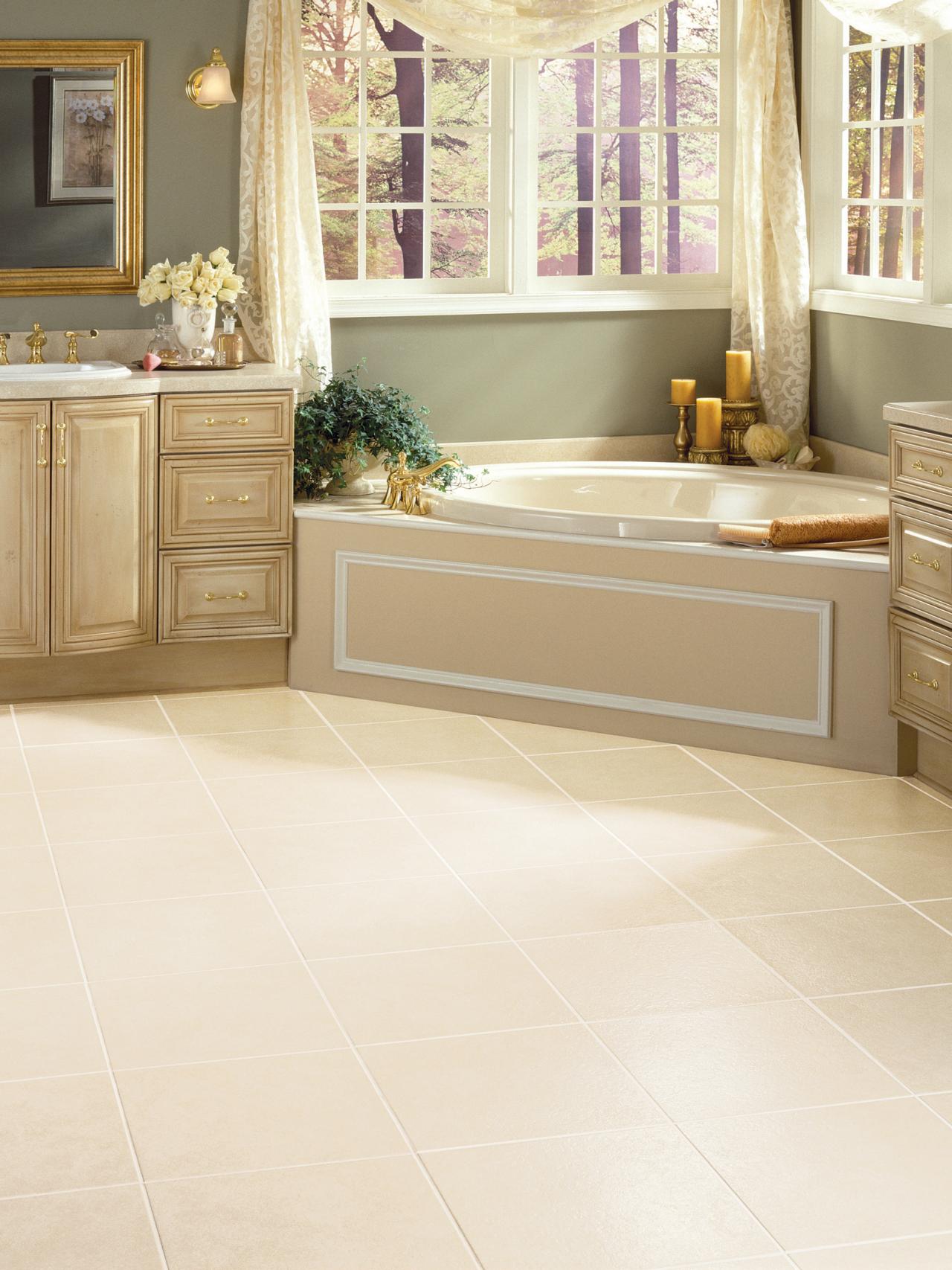
What is the easiest bathroom flooring to maintain?
Luxury vinyl tile (LVT) is one of the easiest bathroom flooring options to maintain. It is waterproof, durable, and resistant to stains and scratches. LVT requires simple cleaning with a damp mop and mild detergent. Porcelain and ceramic tiles are also low-maintenance, needing regular sweeping and occasional mopping to keep them clean. Avoid using harsh chemicals on any bathroom flooring to preserve its finish and longevity. Proper installation and sealing (if applicable) also play a crucial role in reducing maintenance needs.
How do I prepare my bathroom subfloor for new flooring?
Preparing the bathroom subfloor for new flooring involves several steps to ensure a stable and durable installation. Start by removing the old flooring and thoroughly cleaning the subfloor to remove any debris, adhesive, or residues. Check for any damage, such as cracks or moisture issues, and repair them accordingly. Ensure the subfloor is dry, level, and smooth. In cases of significant unevenness, use a self-leveling compound to create a uniform surface. For moisture-prone areas, consider installing a waterproof underlayment or membrane to protect the new flooring.
Are there eco-friendly bathroom flooring options?
Yes, several eco-friendly bathroom flooring options are available. Cork flooring is a sustainable choice, as it is made from the bark of cork oak trees, which regenerate after harvesting. Bamboo is another eco-friendly option, known for its rapid growth and renewable nature. Both cork and bamboo are naturally water-resistant when properly sealed. Recycled glass tiles and reclaimed wood are also environmentally friendly choices, offering unique aesthetics while reducing environmental impact. When selecting eco-friendly flooring, ensure it is suitable for high-moisture environments and properly maintained for longevity.
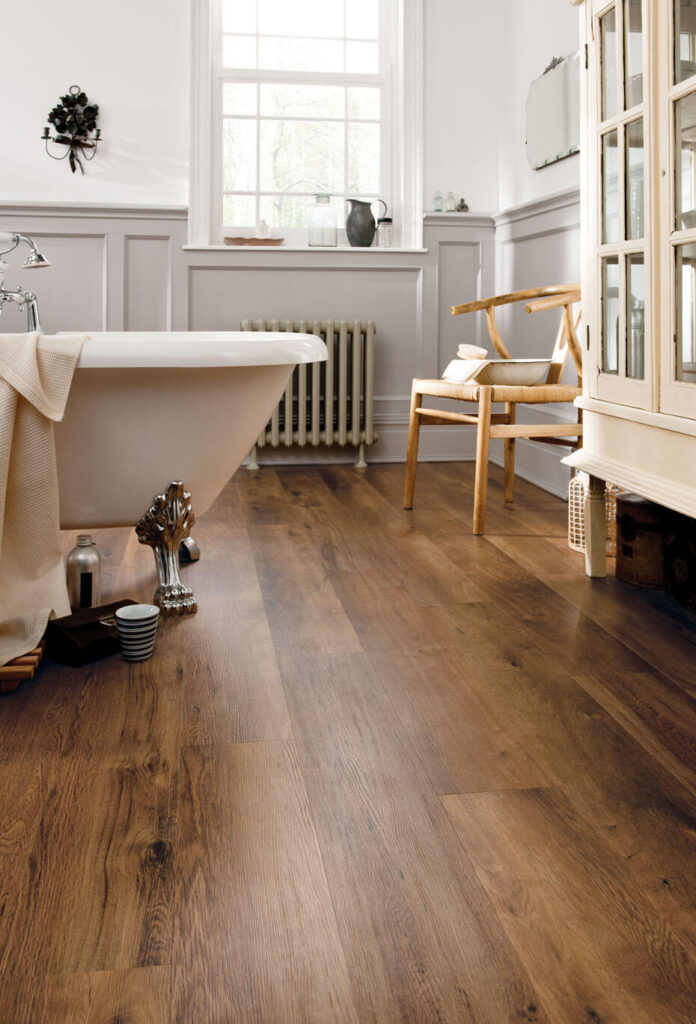
Related Posts:
